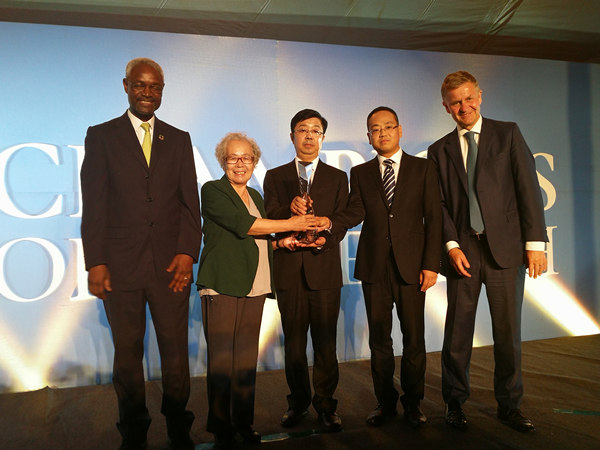


In the midst of noisy climate change politics and complicated science, renowned think tank economist Fan Gang has kept a low profile, calling himself a student.
However, after a year and a half of intensive research, and while ongoing international negotiations remain in deadlock, he and his team have prepared their version of a carbon reduction global treaty.
"I think our biggest achievement is to measure how much responsibility each country in this world should shoulder to mitigate global warming," Fan, a leading member of the Beijing-based think tank called 50 Economists Forum, told China Business Weekly during a recent interview on his research findings.
The United Nations-sponsored scientists have concluded that the earth's temperature will increase by 2 degrees Celsius, which would be catastrophic, without dramatic changes to reduce global temperatures. The UN scientists reported that each country should share a "common, but differentiated responsibility" in the fight against global warming.
But the matter has led to a stalemate in negotiations leading up to the international Copenhagen climate change summit in December, which is going to seek a global deal to replace the Kyoto Protocol that expires in 2013. The global carbon reduction burden over the years 2013 to 2030 would amount to 283 gigatons (A gigatons is 1 billion tons.) to reduce global warming to prevent the 2-degree rise, scientists have reported.
"To find how much to mitigate is the precondition of negotiations," Fan said.
The second step for Fan's team is to allocate the burden, which he said was created largely by the industrialized nations' emissions from 1850 until 1950.
"Each country, however rich or poor it may be, should be allocated a portion of the burden, since their residents' consumption have had a warming impact on the earth," said Fan, who is also president of the China National Economic Research Institute.
"After decades of development, world-level new riches have already appeared in China despite the fact that millions of people still live a poor life," he said. " In this way, I think China should at least commit to a long-term carbon reduction goal. We should not base our stances on the old international treaties."
The Kyoto Protocol and Bali Climate Change Roadmap have stated that developing countries should have no responsibility to commit to a goal of a binding reduction of greenhouse gases, but that industrialized countries should take the responsibility.
However, Fan said the so-called Annex-1 countries (37 advanced industrialized countries) of the Kyoto Protocol have not fulfilled their commitments to providing funding and technologies to the developing countries, and thus, there is no incentive for developing countries to cut more greenhouse gases voluntarily.
How and when non-Annex-1 countries and developing countries join the binding agreement is still an uncertainty, he said.
"So we need to sort it out and design a new framework for the upcoming Copenhagen deal," Fan said.
After careful calculation by modeling, Fan's team determined that the United States should burden the biggest share of the global greenhouse gas reduction responsibility, which is 37.4 percent of the total 283 gigatons (GT) of carbon reduction. And the European Union should burden 34 percent of the responsibility, Fan said.
For emerging economies, because of their low historic responsibility, China should be responsible for 1.6 percent of the carbon burden, Russia 2.1 percent, Brazil 1.8 percent and South Africa 0.5 percent. India's share should be zero due to its slow urbanization and industrialization, he said.
After taking transferred emissions through trade into account, Fan and his team used "accumulated consumption emission" per capita from 1950 through 2005 to measure individual countries' reduction responsibilities and to take the lowest such emissions in Annex-I countries of the Kyoto Protocol as the "standard threshold" for joining the binding treaty.
His team found that Romania, which committed to a binding target for the 2008-2012 period, along with 36 other Annex-1 countries and accumulated 144 tons of greenhouse gases during the 1950-2005 period as a benchmark country.
Per capita accumulated consumption emissions in the United Kingdom and United States have largely surpassed the threshold, reaching 1,186 tons and 966 tons, respectively.
For the emerging economies, Russia and Mexico have overtaken the benchmark, but Brazil and South Africa have come close to it. And India is still far away from the line with 35 tons of per capita consumption emissions during the 1950-2005 period.
In Fan's climate treaty framework, if the countries' accumulated consumption emissions have surpassed the threshold, they must join the binding treaty, while other countries can start to cut emissions voluntarily. The more they do before they reach the threshold, the later they have to join the binding treaty.
Fan added that the countries that are subject to a binding treaty should commit to providing financial and technology support, including the removal of all bans or restrictions on transfers of mitigation technologies.
The accumulated CO2 emissions per capita in China in 2005 reached 45 tons.
"Our modeling results have shown that China will reach Romania's emissions level by 2050, and so I am suggesting the Chinese government commit to a ceiling target 40 ears later," Fan said.
Other voices
The growth model transfer is the focus of climate change negotiations, and China should take a proactive approach to advocate low carbon development, said Chi Fulin, president of the China (Hainan) Reform and Development Research Institute.
"Actually, it's not only because of the urgency of climate crisis, but also because of the energy crisis. The limited oil, natural gas and coal reserves can't sustain the old way of growth, and we must resort to other means," Chi said.
Chi said the upcoming UN climate change summit and Copenhagen negotiation have provided China an opportunity to take the lead in advocating low carbon growth, which can help resolve energy shortages and stop slow catastrophic climate change
"I firmly agree that China needs to set a carbon emission cap by 2020 to ensure a better quality of living at home and responsible role in the world," Chi said, adding that time is ripe for China to integrate its domestic and international development strategies.
However, some influential think tank experts are against taking a proactive stance.
"I don't agree that China should commit to a binding reduction goal right now," said Zou Ji, a professor at Renmin University of China.
Zou said China should focus on carbon reduction as part of its domestic agenda. China has set a goal of reducing energy consumption intensity by 20 percent from 2005 levels for the 2006-2010 period. China also likely will include cutting carbon intensity when the country implements its 12th five-year plan in 2011.
"But at the international level, we should not commit to a target to lose our development right," Zou said, adding that the current treaties have allowed developing countries "emission rights" to ensure economic growth.
Zou said there is a projection that China's carbon emissions will peak in 2030 if increased reduction efforts are put in place in the future.
(China Daily 11/16/2009 page2)













